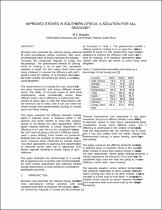JavaScript is disabled for your browser. Some features of this site may not work without it.
- ResearchSpace
- →
- Research Publications/Outputs
- →
- Conference Publications
- →
- View Item
| dc.contributor.author |
Mapako, MC

|
|
| dc.date.accessioned | 2011-07-01T07:21:32Z | |
| dc.date.available | 2011-07-01T07:21:32Z | |
| dc.date.issued | 2011-04 | |
| dc.identifier.citation | Mapako, MC. 2011. Improved stoves in Southern Africa: a solution for all seasons. 19th International Conference on the "Domestic Use of Energy", Bellville Campus, Cape Peninsula University of Technology, Cape Town, 11-13 April 2011, pp 49-53 | en_US |
| dc.identifier.isbn | 978-0-9814311-4-7 | |
| dc.identifier.uri | http://hdl.handle.net/10204/5075 | |
| dc.description | 19th International Conference on the "Domestic Use of Energy", Bellville Campus, Cape Peninsula University of Technology, Cape Town, 11-13 April 2011 | en_US |
| dc.description.abstract | Biomass fuels dominate the national energy balances of most sub-Saharan African countries, with wood contributing 80-90% of poorer countries like Ethiopia, Tanzania, the Democratic Republic of Congo and Mozambique. The predominant method of utilising wood for cooking is on an open fire, considered wasteful of wood. For this reason there have been many initiatives to improve the efficiency with which wood is used for cooking, or to introduce alternatives like solar cookers and ethanol gel stoves to avoid using wood altogether. The requirements of a cooking fuel vary seasonally in any given household, and across different climatic zones. The ability of improved stoves to meet these requirements varies considerably across these different zones, and if efficiency is understood in the context of being able to meet the requirements with the minimum use of wood, then it can vary when the needs change from predominantly cooking, to include space and water heating. This paper examines the different domestic heating loads in selected areas in Southern Africa in the summer and winter months to show that cooking energy is not always the main requirement. Where space heating becomes a critical requirement the efficiency of an open fire can be considered high since the ‘lost’ heat not going to the pot is fulfilling a critical need – space heating. Case studies are presented to illustrate how the reception of improved stoves has in some instances been influenced by climatic factors. Top down approaches to planning and dissemination of improved stoves often fail to appreciate such factors, typically resulting in limited impact of such initiatives. The paper illustrates the shortcomings of a one-size fits all approach and concludes with recommendations for more careful assessment and matching modern energy interventions to local conditions to ensure more predictable outcomes. | en_US |
| dc.language.iso | en | en_US |
| dc.relation.ispartofseries | Workflow;6521 | |
| dc.subject | Energy | en_US |
| dc.subject | Stoves | en_US |
| dc.subject | Climate | en_US |
| dc.subject | Southern Africa | en_US |
| dc.title | Improved stoves in Southern Africa: a solution for all seasons | en_US |
| dc.type | Conference Presentation | en_US |
| dc.identifier.apacitation | Mapako, M. (2011). Improved stoves in Southern Africa: a solution for all seasons. http://hdl.handle.net/10204/5075 | en_ZA |
| dc.identifier.chicagocitation | Mapako, MC. "Improved stoves in Southern Africa: a solution for all seasons." (2011): http://hdl.handle.net/10204/5075 | en_ZA |
| dc.identifier.vancouvercitation | Mapako M, Improved stoves in Southern Africa: a solution for all seasons; 2011. http://hdl.handle.net/10204/5075 . | en_ZA |
| dc.identifier.ris | TY - Conference Presentation AU - Mapako, MC AB - Biomass fuels dominate the national energy balances of most sub-Saharan African countries, with wood contributing 80-90% of poorer countries like Ethiopia, Tanzania, the Democratic Republic of Congo and Mozambique. The predominant method of utilising wood for cooking is on an open fire, considered wasteful of wood. For this reason there have been many initiatives to improve the efficiency with which wood is used for cooking, or to introduce alternatives like solar cookers and ethanol gel stoves to avoid using wood altogether. The requirements of a cooking fuel vary seasonally in any given household, and across different climatic zones. The ability of improved stoves to meet these requirements varies considerably across these different zones, and if efficiency is understood in the context of being able to meet the requirements with the minimum use of wood, then it can vary when the needs change from predominantly cooking, to include space and water heating. This paper examines the different domestic heating loads in selected areas in Southern Africa in the summer and winter months to show that cooking energy is not always the main requirement. Where space heating becomes a critical requirement the efficiency of an open fire can be considered high since the ‘lost’ heat not going to the pot is fulfilling a critical need – space heating. Case studies are presented to illustrate how the reception of improved stoves has in some instances been influenced by climatic factors. Top down approaches to planning and dissemination of improved stoves often fail to appreciate such factors, typically resulting in limited impact of such initiatives. The paper illustrates the shortcomings of a one-size fits all approach and concludes with recommendations for more careful assessment and matching modern energy interventions to local conditions to ensure more predictable outcomes. DA - 2011-04 DB - ResearchSpace DP - CSIR KW - Energy KW - Stoves KW - Climate KW - Southern Africa LK - https://researchspace.csir.co.za PY - 2011 SM - 978-0-9814311-4-7 T1 - Improved stoves in Southern Africa: a solution for all seasons TI - Improved stoves in Southern Africa: a solution for all seasons UR - http://hdl.handle.net/10204/5075 ER - | en_ZA |






